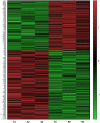Effects of advanced glycation end products on neutrophil migration and aggregation in diabetic wounds
- PMID: 33902006
- PMCID: PMC8109105
- DOI: 10.18632/aging.202924
Effects of advanced glycation end products on neutrophil migration and aggregation in diabetic wounds
Abstract
Increased accumulation of advanced glycation end products (AGEs) in diabetic skin is closely related to delayed wound healing. Studies have shown that the concentration of AGEs is elevated in the skin tissues and not subcutaneous tissues in refractory diabetic wounds, which suggests there may be a causal relationship between the two. In the present study, in vitro experiments revealed that AGEs activated neutrophils, and the migratory and adhesive functions of neutrophils decreased once AGE levels reached a certain threshold. Different levels of AGE expression differentially affected the function of neutrophils. Messenger RNA (mRNA) sequencing analysis combined with real-time polymerase chain reaction (PCR) showed that poliovirus receptor (PVR/CD155) and CTNND1, which play a role in migration- and adhesion-related signaling pathways, were decreased following AGE stimulation. Consequently, neutrophils cannot effectively stimulate the formation of the inflammatory belt needed to remove necrotic tissues and defend against foreign microorganisms within diabetic chronic wounds. In addition, this phenomenon may be related to the differential accumulation of AGEs in different layers of the skin.
Keywords: AGEs; CTNND1; diabetes; neutrophil migration; wound repair.
Conflict of interest statement
Figures








Similar articles
-
D-mannose promotes diabetic wound healing through inhibiting advanced glycation end products formation in keratinocytes.Mol Med. 2025 Jan 18;31(1):15. doi: 10.1186/s10020-025-01070-3. Mol Med. 2025. PMID: 39827347 Free PMC article.
-
Clinical application prospect of umbilical cord-derived mesenchymal stem cells on clearance of advanced glycation end products through autophagy on diabetic wound.Eur J Med Res. 2017 Mar 24;22(1):11. doi: 10.1186/s40001-017-0253-1. Eur J Med Res. 2017. PMID: 28340602 Free PMC article. Review.
-
The Relationship Between Inflammation and Impaired Wound Healing in a Diabetic Rat Burn Model.J Burn Care Res. 2016 Mar-Apr;37(2):e115-24. doi: 10.1097/BCR.0000000000000171. J Burn Care Res. 2016. PMID: 25407384
-
Effect and mechanisms of Polygonatum kingianum (polygonati rhizome) on wound healing in diabetic rats.J Ethnopharmacol. 2022 Nov 15;298:115612. doi: 10.1016/j.jep.2022.115612. Epub 2022 Aug 17. J Ethnopharmacol. 2022. PMID: 35987409
-
The link between advanced glycation end products and apoptosis in delayed wound healing.Cell Biochem Funct. 2019 Aug;37(6):432-442. doi: 10.1002/cbf.3424. Epub 2019 Jul 18. Cell Biochem Funct. 2019. PMID: 31318458 Review.
Cited by
-
Synthetic and Natural Agents Targeting Advanced Glycation End-Products for Skin Anti-Aging: A Comprehensive Review of Experimental and Clinical Studies.Antioxidants (Basel). 2025 Apr 20;14(4):498. doi: 10.3390/antiox14040498. Antioxidants (Basel). 2025. PMID: 40298870 Free PMC article. Review.
-
Delayed Immune Response Upon Injury in Diabetic Wounds Impedes Healing.Immun Inflamm Dis. 2025 Feb;13(2):e70142. doi: 10.1002/iid3.70142. Immun Inflamm Dis. 2025. PMID: 39891428 Free PMC article.
-
Smart self-healing hydrogel wound dressings for diabetic wound treatment.Nanomedicine (Lond). 2025 Apr;20(7):737-754. doi: 10.1080/17435889.2025.2466414. Epub 2025 Feb 18. Nanomedicine (Lond). 2025. PMID: 39964000 Review.
-
A Role for Advanced Glycation End Products in Molecular Ageing.Int J Mol Sci. 2023 Jun 8;24(12):9881. doi: 10.3390/ijms24129881. Int J Mol Sci. 2023. PMID: 37373042 Free PMC article. Review.
-
circCDK13-loaded small extracellular vesicles accelerate healing in preclinical diabetic wound models.Nat Commun. 2024 May 9;15(1):3904. doi: 10.1038/s41467-024-48284-3. Nat Commun. 2024. PMID: 38724502 Free PMC article.
References
Publication types
MeSH terms
Substances
LinkOut - more resources
Full Text Sources
Other Literature Sources
Medical
Research Materials
Miscellaneous

